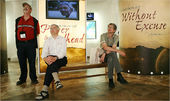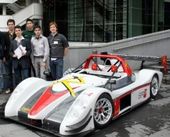
© Mark Lyons for The New York TimesA DIFFERENT VIEWPOINT Peter Dodson, left, of the University of Pennsylvania, Michael Foote of the University of Chicago and Jon Todd of the Museum of Natural History in London watching a video at the Creation Museum.
Petersburg, Ky. - Tamaki Sato was confused by the dinosaur exhibit. The placards described the various dinosaurs as originating from different geological periods - the stegosaurus from the Upper Jurassic, the heterodontosaurus from the Lower Jurassic, the velociraptor from the Upper Cretaceous - yet in each case, the date of demise was the same: around 2348 B.C.
"I was just curious why," said Dr. Sato, a professor of geology from Tokyo Gakugei University in Japan.
For paleontologists like Dr. Sato, layers of bedrock represent an accumulation over hundreds of millions of years, and the Lower Jurassic is much older than the Upper Cretaceous.




